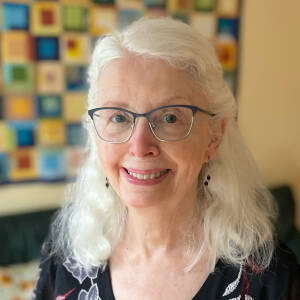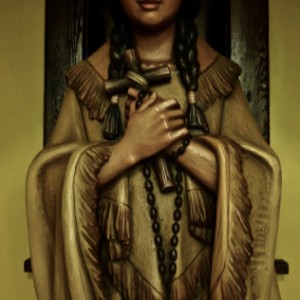Saints and Connections
I may never get to Ireland in person, but thanks to blipper Freespiral, I’ve been able to see quite a lot of the countryside without ever leaving home. In addition to her wide-ranging Blipfoto journal, she has a fascinating blog, Holy Wells of Cork, rich in adventures as she seeks out as many of County Cork’s more than 350 holy wells as possible. Many of these wells have statues of the Blessed Virgin Mary (BVM), such as the one seen in this recent entry.
I rarely see religious statues, but today was an exception. I sing in Whatcom Chorale, and we are performing Handel’s “Messiah” Sunday afternoon in Bellingham’s largest Catholic church, Church of the Assumption. It’s the only church in town big enough (see the extra photo, with set-up for the dress rehearsal underway) to hold 85 choristers, a 23-piece orchestra, four superb soloists, and a sold-out audience..
I arrived early at our dress rehearsal today, giving me time to look at the church’s array of stained glass windows and holy statues, and thought that Freespiral, and perhaps others, might enjoy seeing a couple of the latter. The statue featured in my blip is Our Lady of Guadalupe, also known as the Virgin of Guadalupe, a Roman Catholic title of the Blessed Virgin Mary associated with a venerated image enshrined within the Basilica of Our Lady of Guadalupe in Mexico City. The basilica is the most visited Catholic pilgrimage site in the world, and the world’s most-visited sacred site. (Given the gray skies and short days of this time of year, I was drawn to what looked like sun rays behind her!)
The church also has a statue of a saint associated with a modern miracle right here in Whatcom County. You can see her in the other extra photo — Saint Kateri Tekakwitha, the first Native American to be recognized as a saint by the Catholic Church. Born in 1656 to an Algonquin mother and Mohawk father, Tekakwitha was orphaned at age four following a smallpox outbreak that killed her family and left her with facial scars and impaired eyesight. She was raised by her uncle and his family, but after refusing to marry, at age 19 she converted to Catholicism and was given the name Kateri, the Mohawk form of Catherine, which she took from St. Catherine of Sienna.
Kateri died in 1680, age 23 or 24. In the 1880s, Indian Catholic missions and bishops wrote a petition pushing for the veneration of Tekakwitha, followed by Canadian Catholics. She was beatified by Pope John Paul II in 1980 and canonized by Pope Benedict XVI in 2012, the first Native American woman to be honored with sainthood. St. Kateri is the patroness of ecology and the environment, people in exile, and Native Americans.
And here’s the local connection: In 2006, a five-year-old Whatcom County boy, who was half Lummi Indian, contracted a severe flesh-eating bacterium (necrotizing fasciitis). Despite heroic medical efforts, nothing could stop the disease’s progression, and his doctors told his parents that he was likely to die. Devout Catholics, the family prayed through Tekakwitha for divine intercession, as did their friends and the families of their son’s classmates. I remember reading several front-page articles in our local newspaper about this tragic situation.
A family friend — a nun named after Kateri — visited the boy and his family in the hospital, bringing a relic of the soon-to-be saint and placing it on his leg. The next day, the disease’s progress halted, and the boy survived. This was the second miracle attributed to Kateri Tekakwitha, and her canonization followed six years later.
[Note: I used a variety of websites, including Wikipedia and several Catholic websites, to gather information for this journal entry.]
Blip 1897



Comments
Sign in or get an account to comment.


